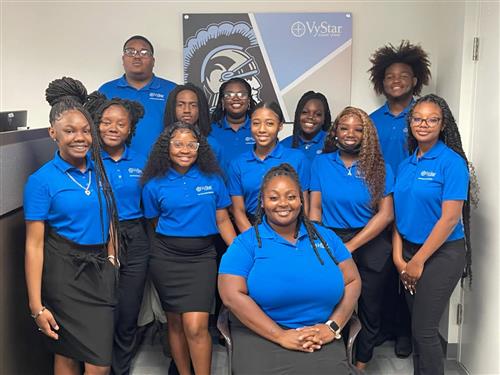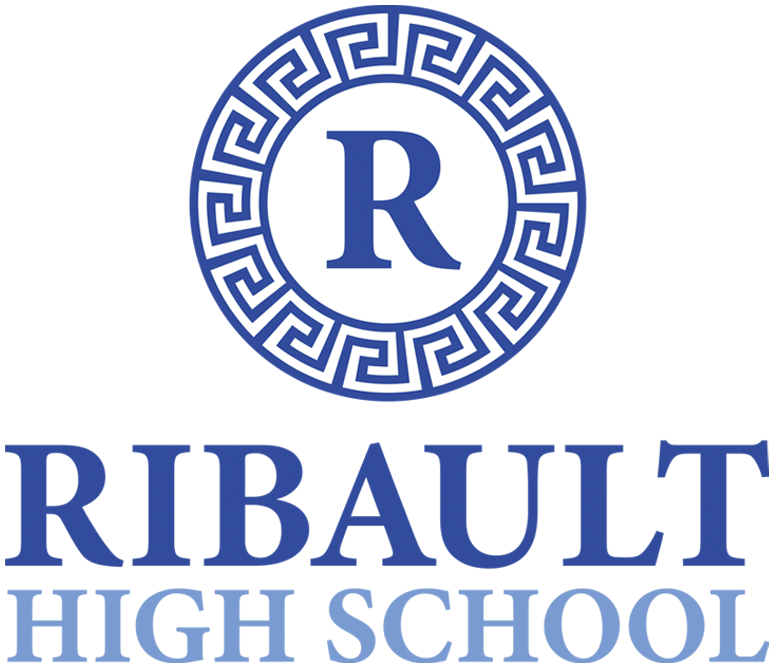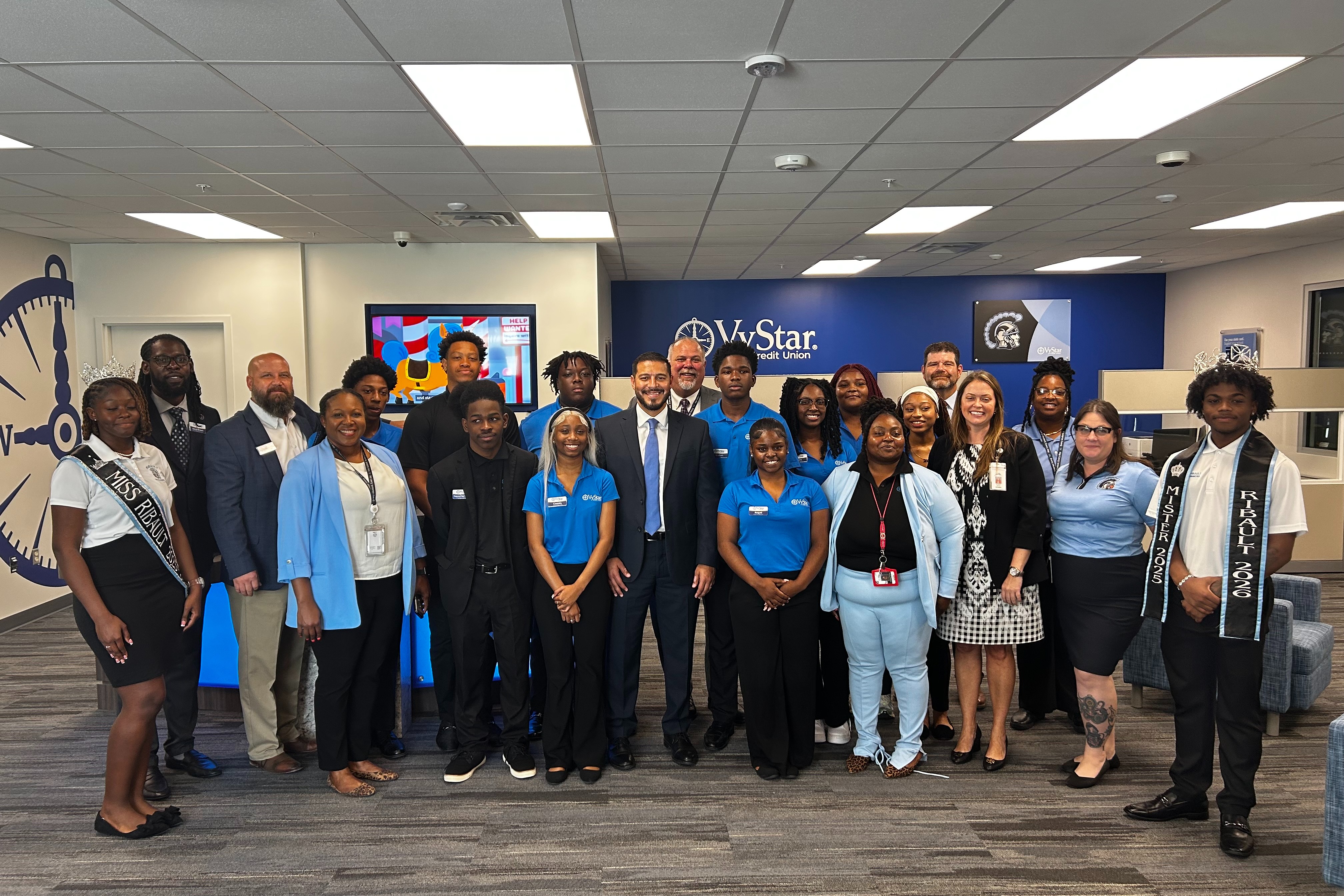

VyStar Credit Union converted a classroom on our campus to an operating branch run by students. It is the cornerstone of the VyStar Academy of Business and Entrepreneurship at Jean Ribault High School and is available every lunch period for anyone on campus to open and service their accounts.
Bring your school ID or driver license, social security number, address and $5 to start your free membership. With every savings account, members receive a Ribault High School ATM card that can be used at hundreds of local machines, and any branch, at no charge.
Need some lunch money? Drop in the school branch and make a withdrawal. Need to start a direct deposit of your paycheck? We'll get you what you need. Want to open a CD? We'll help you do that. These are real accounts.
We accept applications for the position of student manager intern January and February. Applicants are selected for interview with a panel of JRHS and VyStar instructors and administration. Twelve are selected to become paid interns and operate all facets of the high school branch for the following school year.
See an Intern to open your account today!
Academy Director: Miss LaQuanda Paschal

Program Sequence
9th grade: Digital Information and Technology - This core course is designed to provide a basic overview of current business and information systems and trends, and to introduce students to fundamental skills required for today's business and academic environments. Emphasis is placed on developing fundamental computer skills. The intention of this course is to prepare students to be successful both personally and professionally in an information-based society. Digital Information Technology includes the exploration and use of: databases, the internet, spreadsheets, presentation applications, management of personal information and email, word processing and document manipulation, HTML, web page design, and the integration of these programs using software that meets industry standards.
After successfully completing this program, the student will be able to perform the following:
01.0 Demonstrate knowledge, skill, and application of information technology to accomplish job objectives and enhance workplace performance.
02.0 Develop an awareness of microcomputers.
03.0 Demonstrate an understanding of networks.
04.0 Use word processing applications to enhance the effectiveness of various types of documents and communication.
05.0 Use presentation applications to enhance communication skills.
06.0 Use spreadsheet applications to enhance communication skills.
07.0 Use database applications to store and organize data.
08.0 Use electronic mail to enhance communication skills.
09.0 Investigate individual assessment and job/career exploration and individual career planning that reflect the transition from school to work, lifelong learning, and personal and professional goals.
10.0 Incorporate appropriate leadership and supervision techniques, customer service strategies, and standards of personal ethics to accomplish job objectives and enhance workplace performance.
11.0 Demonstrate competence using computer networks, internet, and online databases to facilitate collaborative or individual learning and communication.
12.0 Develop awareness of computer languages, web-based & software applications, and emerging technologies.
13.0 Demonstrate an understanding of basic html by creating a simple web page.
14.0 Demonstrate comprehension and communication skills.
15.0 Use social media to enhance online communication and develop an awareness of a digital footprint.
16.0 Demonstrate and apply oral and written communication skills in creating, expressing, and interpreting information and ideas in a personal and professional manner.
17.0 Use technology to enhance the effectiveness of communications to accomplish job objectives and enhance workplace performance.
18.0 Analyze current and emerging trends to determine potential impact on career and job objectives and workplace performance.
19.0 Demonstrate an awareness of management functions and organizational structures as they relate to today’s workplace and employer/employee roles.
20.0 Practice quality time management in the learning environment and the workplace.
21.0 Solve problems using critical thinking skills, creativity, and innovation.
22.0 Demonstrate mathematics knowledge and financial planning strategies and skills.
23.0 Assess personal strengths and weaknesses as they relate to job objectives, career exploration, personal development, and life goals.
24.0 Justify the need to gain and maintain competitive advantage.
25.0 Perform human resources management activities.
26.0 Analyze the impact and relationship of government regulations and community involvement on business management decisions.
27.0 Create a business plan (e.g., start-up, expansion, lean business model).
28.0 Describe accounting management functions and organizational structures as they relate to today’s workplace and employer/employee roles.
29.0 Practice quality performance in the learning environment and the workplace.
30.0 Apply mathematical operations and processes as well as financial planning strategies to commonly occurring personal and business situations.
31.0 Assess personal strengths and weaknesses as they relate to job objectives, career exploration, personal development, and life goals.
32.0 Apply accounting principles and concepts to the performance of accounting activities.
33.0 Participate in work-based learning experiences in class or online.
34.0 Describe how formulating policies and guiding the change process supports the organization’s mission and strategic goals.
35.0 Research and explain how evaluating organizational effectiveness contributes to the overall strength of the business.
36.0 Describe how sourcing and recruitment planning are important to the organization’s ability to achieve goals and objectives.
37.0 Explore and discuss how hiring and retention planning are critical to organizational success.
38.0 Research and develop tools and programs that support employee training and professional development.
39.0 Research and evaluate compensation and benefits programs and their impact on organizational goals, objectives, and values.
40.0 Explore the manner and importance of maintaining relationships and working conditions to balance employer and employee needs and rights in support of organizational goals and objectives.
41.0 Evaluate how to provide a safe and secure work environment that protects the organization from liability.
42.0 Research the roles and working relationships of a business analyst and project manager and describe key deliverables of the business analysis process.
43.0 Evaluate business and financial information to support internal decision-making.
44.0 Demonstrate fundamental techniques and methods used in the analysis of computerized business activities, including information requirements and resources, as well as the impact on business decisions.
45.0 Describe the implications of professional values, ethics, and attitudes in business.
46.0 Demonstrate an understanding of business law concepts.
47.0 Demonstrate an understanding of different types of insurance.
48.0 Practice quality performance in the workplace.
10th grade: Business and Entrepreneurial Principles - This course is designed to provide an introduction to business organization, management, and entrepreneurial principles. Topics include communication skills, various forms of business ownership and organizational structures, supervisory/management skills, leadership skills, human resources management activities, business ethics, and cultural diversity. Emphasis is placed on job readiness and career development. The use of computers is an integral part of this program.
16.0 Demonstrate and apply oral and written communication skills in creating, expressing, and interpreting information and ideas in a personal and professional manner. The student will be able to:
16.01 Communicate in a diverse and flexible setting (e.g., with people from varying international, cultural, ethnic, and racial backgrounds).
16.02 Project a positive impression in person and acknowledge the importance of making eye contact.
16.03 Organize and lead team, board, or department discussions.
16.04 Demonstrate and apply active listening techniques and overcome major barriers to listening to obtain and clarify information.
16.05 Identify relevant information in oral communications.
16.06 Interpret and give examples of verbal and nonverbal cues/behaviors that enhance communication in various cultures.
16.07 Demonstrate an understanding of the importance of establishing and maintaining a work-related network through social contacts and discuss how to use business-oriented social networking.
16.08 Design, develop, and deliver formal and informal presentations to engage and inform diverse audiences.
17.0 Use technology to enhance the effectiveness of communications to accomplish job objectives and enhance workplace performance. The student will be able to:
17.01 Compose and create business communications appropriate for specific audiences.
17.02 Revise business documents and e-mails to ensure they are clear, correct, concise, complete, consistent, and courteous.
18.0 Analyze current and emerging trends and determine potential impact on career and job objectives and workplace performance. The student will be able to:
18.01 Identify and analyze changing trends in the marketplace.
19.0 Demonstrate an awareness of management functions and organizational structures as they relate to today’s workplace and employer/employee roles. The student will be able to:
19.01 Define and identify the different levels of management.
19.02 Identify and define the various forms of business ownership (e.g., sole proprietorships, partnerships, corporations) and other organizational structures (e.g., nonprofit organizations, governmental agencies).
19.03 Analyze organizational charts and discuss how various supervisory/management positions fit into the organizational structure.
19.04 Define the entrepreneurial mindset (e.g., opportunity, recognition, risk, and reward) and discuss its importance to the global economy.
20.0 Practice quality time management in the learning environment and the workplace. The student will be able to:
20.01 Discuss the importance of time management, both professional and personal, including the consequences of poor time management skills.
20.02 Perform a personal time management analysis.
21.0 Solve problems using critical thinking skills, creativity, and innovation. The student will be able to:
21.01 Employ critical thinking skills independently and in teams to solve problems and make decisions.
21.02 Employ critical thinking and interpersonal skills to resolve conflicts.
21.03 Identify and document workplace performance goals and monitor progress toward those goals.
21.04 Conduct technical research to gather information necessary for decision-making.
22.0 Demonstrate mathematics knowledge and financial planning strategies and skills. The student will be able to:
22.01 Demonstrate knowledge of arithmetic operations.
22.02 Analyze and apply data and measurements to solve problems and interpret documents.
22.03 Construct charts/tables/graphs using functions and data.
22.04 Describe the importance of financial statements.
23.0 Assess personal strengths and weaknesses as they relate to job objectives, career exploration, personal development, and life goals. The student will be able to:
23.01 Identify career paths in managerial leadership and small business environments.
23.02 Participate in work-based learning experiences in a managerial leadership or small business environment.
23.03 Demonstrate the use of technology in a managerial leadership or small business environment.
23.04 Compare and contrast software applications used in a managerial leadership or small business environment.
23.05 Develop an understanding of the integral value of a customer and practice the skills required to provide excellent customer service.
24.0 Justify the need to gain and maintain competitive advantage. The student will be able to:
24.01 Identify ways in which businesses compete. (e.g., quality, service, status, price).
24.02 Define market share.
24.03 Identify various forms of competition (e.g., pure competition, oligopoly, monopolistic competition, monopoly).
25.0 Perform human resources management activities. The student will be able to:
25.01 Identify the benefits of professional staff development (e.g., workshops, conferences, course work, membership in professional associations).
25.02 Explain, create, and perform employee evaluations; describe the procedures used in the evaluation process, and identify the consequences of positive or negative performance appraisals.
25.03 Describe and research current legislation affecting the workplace and discuss the impact on businesses (e.g., affirmative action, right to privacy, drug testing, sexual harassment, safety).
25.04 Identify employee benefits (e.g., insurance plans, retirement plans; payroll deductions for savings bonds, cafeteria plans, 401K plans) and describe the proposal process of acquiring and negotiating benefits.
25.05 Describe methods used to compensate employees (e.g., minimum wage, wages, salary, commission). Describe the methods to negotiate employee compensation and the role of benchmark surveys.
25.06 Define “downsizing” and explain why it occurs and the impact of reducing workforce size.
26.0 Analyze the impact and relationship of government regulations and community involvement on business management decisions. The student will be able to:
26.01 Explain how tax policies, licensure requirements, and governmental regulations affect a business.
26.02 Identify ways companies can help their communities (e.g., jobs, taxes, contributions to community projects).
27.0 Create a business plan (e.g., startup, expansion, lean business model). The student will be able to:
27.01 Identify factors of strategic planning and define the role of strategic planning in a business industry.
27.02 Define the purpose of a business plan and describe the major components included in a business plan.
27.03 Define the marketing concept and explain its impact on consumers.
27.04 Identify and describe examples of diverse marketing activities.
11th grade: Accounting Applications I - This course emphasizes double-entry accounting; methods and principles of recording business transactions; the preparation of various documents used in recording income, expenses, acquisition of assets, incurrence of liabilities, and changes in equity; and the preparation of financial statements. The use of computers and appropriate software is required.
12th grade: Management and Human Resources - This course explores the reach and impact of managing people, one of the most important resources of an organization. Students are required to perform higher-level strategic thinking. Topics include; management policy development, evaluating organizational effectiveness, sourcing and recruitment, hiring and retention planning, employee training, performance appraisals, compensation and benefit programs, maintaining working conditions, and providing a safe working environment.
Course Purpose:
This program offers a sequence of courses that provides coherent and rigorous content aligned with challenging academic standards and relevant
technical knowledge and skills needed to prepare for further education and careers in the Business Management and Administration career cluster; provides technical skill proficiency, and includes competency-based applied learning that contributes to the academic knowledge, higher-order reasoning and problem-solving skills, work attitudes, general employability skills, technical skills, and occupation-specific skills, and knowledge of all aspects of the Business Management and Administration career cluster.
The content includes but is not limited to communication skills, forms of business ownership and organizational structures, supervisory/management functions and skills, accounting concepts and practices, business law concepts, leadership skills, business ethics, governmental regulations, human resources and management issues, financial and data analysis, database development and queries, and career development.

